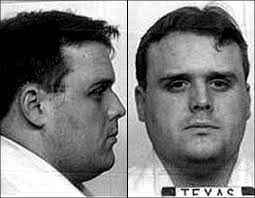Kenneth Rouse Murders Hazel Colleen Broadway
Kenneth Rouse was sentenced to death by the State of North Carolina for the murder of Hazel Colleen Broadway
According to court documents Kenneth Rouse would go into a store where he would attack Hazel Colleen Broadway who would be sexually assaulted and murdered. Police would find Kenneth Rouse still at the scene and he was arrested
Kenneth Rouse would be convicted and sentenced to death
Kenneth Rouse Photos

Kenneth Rouse Now
| KENNETH B ROUSE | |
| Offender Number: | 0353186 |
| Inmate Status: | ACTIVE |
| Gender: | MALE |
| Race: | BLACK/AFRICAN AMERICAN |
| Ethnic Group: | NOT HISPANIC/LATINO |
| Birth Date: | 02/01/1963 |
| Age: | 60 |
| Current Location: | CENTRAL PRISON |
Kenneth Rouse Case
On 16 March 1991, a Saturday, at 10:30 p.m. Andrew Surratt entered a convenience store, The Pantry, in Asheboro, and noticed that a cigarette stand was knocked over and that cigarettes were scattered about the floor. He called out for the clerk but heard no response. He left and called the police from a pay phone nearby.
*549 Several officers soon arrived at The Pantry. Officer Mark Hinshaw of the Asheboro Police Department responded to the call and arrived at The Pantry at 10:39 p.m. He checked the aisles and found nothing suspicious. He heard a muffled sound coming from a storage room. He and Sergeant York, who had arrived at the scene, entered the room where they found defendant against a wall. Hinshaw aimed his gun at defendant, and defendant said, “I ain’t got nothing, man.”
Kenneth Rouse had blood on him, especially on the front of his shirt, his pants, his hands, his waist, his legs and his underwear. There were abrasions on his knees. His pants were unzipped but fastened at the top. His belt was hanging off. Hinshaw ordered defendant to freeze and pinned him behind the door. Defendant was then handcuffed and taken out of the room. Lieutenant Charles Bulla searched defendant in the store and found in defendant’s pocket three rolls of pennies in a plastic container. Kenneth Rouse was then taken away. Defendant did not resist the officers at this or any time. No odor of alcohol was found on defendant’s breath.
On the floor of the storage room was Hazel Colleen Broadway, lying in a pool of blood. She tried to tell Hinshaw something but soon died. Broadway was covered in blood. There were handprints on her body. She was wearing a blouse, and her pants had been pulled down to her feet. Paramedics who had arrived at the scene removed her smock in an attempt to apply cardioelectrodes to her body, at which time they noticed a knife in Broadway’s neck. The blade part of the knife was bent in a ninety-degree angle just below the handle.
More officers soon arrived at the scene who surveyed the store and collected evidence. The store was in disarray. A cigarette stand was overturned, and cigarettes were strewn about the floor. The cash register was turned sideways. Two empty rolls for pennies were on the floor. There was some other debris on the floor beside a trash can and some other penny rolls which seemed to have been knocked out of the safe. The bar stool behind the cash register had some blood on it. There were also spots of blood near the cash register.
Forensic serologist Lucy Milks concluded that the blood on defendant’s hands, shirt and underwear was consistent with samples of blood taken from the victim. The blood on his pants was not. She found no spermatozoa in the vaginal, rectal or oral smears of the victim. She also did not find semen on the victim’s clothing. Forensic chemist Glenn Parham tested defendant for the presence of drugs but found none.
Debra L. Radisch, Associate Chief Medical Examiner of North Carolina, concluded that the victim died as a result of blood loss caused by a stab wound to the left neck, severing the carotid artery and jugular vein. A person could live ten to fifteen minutes after being stabbed in that location. In addition to the lethal knife wound, there were numerous other wounds to the victim including bruises, stab wounds and abrasions to her neck, chest, stomach, arms, shoulders, thighs, knee, palm, thumb, back, and elbow. Many of these were consistent with a sharp cutting instrument. Other injuries were consistent with a blunt instrument. No injuries were found on the victim’s genital and rectal areas.
Robert E. Neill of the SBI crime laboratory, an expert in hair examinations, found one pubic hair from a black person in the pubic combings taken from the victim. This hair was microscopically consistent with a sample taken from defendant. A pubic hair found on defendant’s undershorts and a pubic hair found on defendant’s pants originated from a white person and was microscopically consistent with the victim’s hair. Five head hair fragments were found on the victim’s thighs and six on her buttocks that originated from a black person. Defendant’s pubic hairs were unique when compared to those of other black persons.
Kenneth Rouse entered evidence relating to his mental condition. Defendant used his school records and testimony from his mother to show the following: Defendant had difficulty in school and was described as being slow. At age fourteen he was struck by a truck and sustained a head injury. Defendant failed *550 the ninth grade and never returned to school. Tests showed his IQ to range between 59 and 80. He often became confused when his mother gave him various tasks, and he was often depressed. In 1983 he was admitted to a hospital for an overdose of Phenergan with Codeine; he was then referred to a mental health clinic. Later he was admitted to the hospital when he slashed his wrists.
Forensic psychiatrist Dr. Robert Rollins, Jr., testified that he diagnosed Kenneth Rouse as having organic personality disorder, which is denoted by impaired brain functioning. This disorder is associated with mood changes, poor impulse control, poor social relationships, suspiciousness and paranoia. Defendant has a history of substance abuse, especially crack cocaine and alcohol. He also diagnosed defendant with mixed personality disorder. As a result of defendant’s disorders, he had impaired functioning, such as poor planning and judgment. On 16 March 1991, defendant’s ability to make and carry out plans was impaired. Defendant’s IQ tests show that he is between mentally retarded and low average.
On cross-examination it was revealed that Dr. Rollins spoke to defendant on two occasions for a total of 130 minutes. Kenneth Rouse told Dr. Rollins that on the evening of 16 March 1991 he was using crack cocaine and alcohol. In a report from 1987 defendant indicated that he could make his own decisions and that he was working full time. Rollins characterized defendant’s suicide incidents as “gestures,” noting that they occurred after family arguments and that the wounds to the wrists were only superficial. Kenneth Rouse was employed from 1989 to the date of the crime. Defendant was competent to stand trial; he was able to help his attorneys, and he understood what his case was about.
The State then presented several witnesses in rebuttal. A former co-worker testified that defendant performed his job well and that he had no trouble conversing with defendant. A cellmate testified that Kenneth Rouse played chess, talked with other inmates, exercised and read; he acknowledged, however, that defendant “wasn’t dealing with a full deck.” A former supervisor testified that defendant was a diligent and efficient worker.
https://law.justia.com/cases/north-carolina/supreme-court/1994/120a92-0.html













